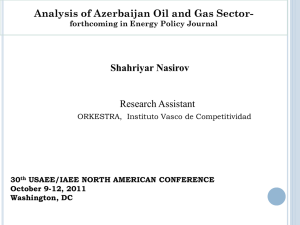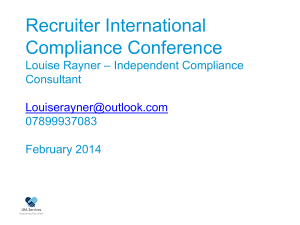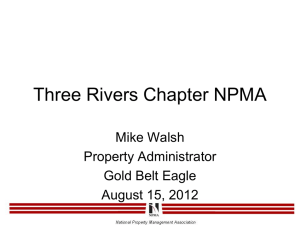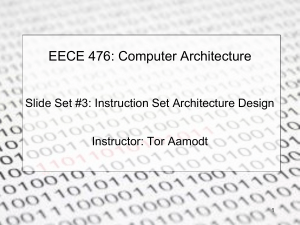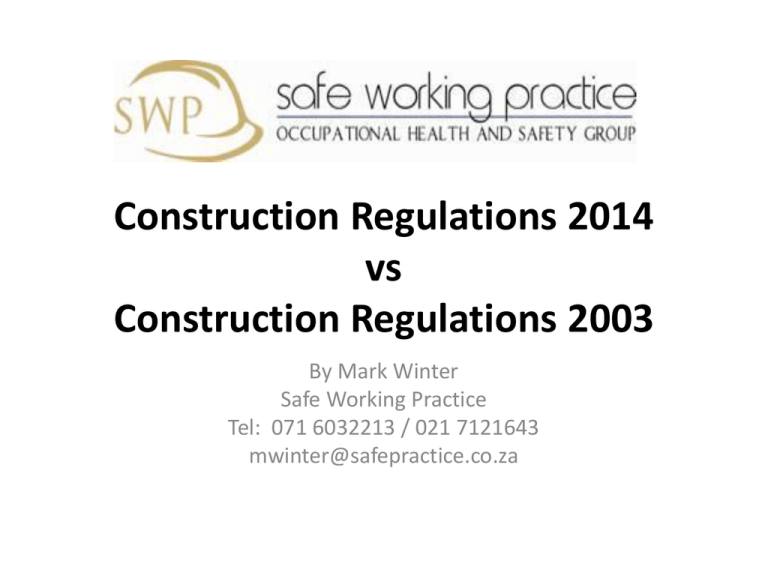
Construction Regulations 2014
vs
Construction Regulations 2003
By Mark Winter
Safe Working Practice
Tel: 071 6032213 / 021 7121643
mwinter@safepractice.co.za
•
Why the new Construction Regulations?
•
What are the Main differences between the
2003 and 2014 Construction Regs?
Where physical construction work started
after 7th February 2014 itwill fall under the
2003 regs until 7th August 2014, ie: 6 month
lead in.
Where physical construction started on or
before 7th February 2014 it will fall under the
2003 regs until 6th August, 2015, ie: 18 month
lead in.
2003 Regs – an “Agent” means any person who acts
as a representative for a client
2014 Regs – An “Agent” means a competent person
who acts as representative for the client
Competent person must have training, knowledge
and experience and, where applicable, qualifications
specific to task – SAQA registration of training and
qualifications – and must be familiar with the Act
and applicable Regs
New Position Introduced: Construction Manager
Is a competent person to manage physical
construction processes and co-ordinate resources
on site
No existing SAQA unit standards for training yet
Definition of Construction Supervisor now added
Is a competent person to supervise construction
activities on site
Under 2003 Regs was any person who prepared a
design, checked and approved a design, arranged
for an employee (or person at work under his
control) to prepare a design, architects and
engineers contributing to (or overall responsibility)
for design, surveyors, contractors doing design
work, designs temporary work, interior designer,
shop fitter or landscape architect
Under 2014 Regs must be a competent person
Definition of method statement removed in 2014
regs
Batching plant now called bulk mixing plant
Explosive Powered Tool has been changed to
Explosive Actuated Fastening Device
Body belts removed from fall prevention equipment
definition in 2o14 regs
Not much in the way of changes:
Medical certs of fitness for all
Appointment of Construction Manager,
Construction Supervisors
No requirement to carry proof of induction
anymore, just records on site
Site specific safety plans
Prepare a baseline risk assessment for the intended construction
project
Prepare a suitable, sufficiently documented and coherent site specific
health and safety specification based on the baseline risk assessment
Provide the designer with the health and safety specification
Ensure designer takes safety specification into consideration during
the design stage
Ensure that the designer carries out all responsibilities in Reg 6
Include the safety specification in the tender documents
Inspect site at least once every 30 days
Copy of safety audit report must be issued to Principal Contractor
within 7 days of the audit
When there is a fatality or permanent disabling injury on site – ensure
contractor reports it to DOL and that the report includes measures taken
by contractor to make site safer
Where more than one Principal Contractor appointed, client must ensure
co-operation between Principal Contractor and contractors ref these
regs.
Client may appoint competent person as agent where notification other
than Construction Work Permit application to DOL is required (ie: under
reg 4(1)). Note that decision of DOL final if there is a question over
whether an agent is required or not
Assume responsibility for legal safety
obligations of the client.
Agent MUST manage h&s on site for the
client
Agent MUST be registered with SACPCMP –
this requirement commences August 7, 2015
Construction Health and Safety Officer (CHSO)
Construction Health and Safety Manager (CHSM)
Construction Health and Safety Agent (CHSA)
Provision made for candidates in each
category
Reg 34 only makes mention of Reg 3 and
5(7)(b) which is about the permit and
client/agent – must be registered in 18
months – what about safety officers? – do
they also have 18 months because Reg 34
does not include them?
Experience and qualifications and referrals
Professional Registration vs Membership of
safety associations
Professional Indemnity Insurance
Price important but not the deciding factor –
quality vs price
Duties formerly under Reg 9 – Structures of 2003 Regs. New section for2014 Regs
1
Incorporate all applicable safety standards into design
2
Take h&s specs into consideration
3
Before tender, make available in a report to client (a) all health and safety
information of the design that may effect pricing of the construction work, (b) the
geotechnical-science aspects and (c) the loading structure can withstand
4
Inform client in writing of any anticipated dangers or hazards relating to
construction, make available all info for safe execution of work upon being
designed or when design altered
5
Refrain from including dangerous procedures or materials hazardous to people
When mandated by the client:
Carry out inspections at appropriate stages to verify
construction carried out as per design
Stop works not in accordance with design’s h&s aspects
In final inspection of completed structure, include h&s
aspects, declare structure safe for use and issue completion
certificate
Take ergonomic related hazards into account in design
If designer not mandated by the client then client agent must
do the above
Still requirement for owner to do safety audits once
every 6 months for first 2 years, thereafter annually
Contractor must notify DOL at least 7 days before work starts,
on Annexure 2 if work includes:
Excavation work
Working at height where there is a risk of falling
demolition of structure, or
Use of explosives
Where contractor constructs single storey dwelling for client
who will reside in building, contractor must notify DOL at
least 7 days before start of work on Annexure 2
The Client must apply for permit within 30 days or more before the start
of the construction for a permit if the work:
1.
Exceeds 180 days
2.
Involve more than 1800 person days
3.
Value of contract equals or is higher than R 13 000 000.00, or has a CIDB
grading of level 6
4.
This requirement will be in force 18 months from February 10, 2014
5.
NOTE: Client MUST appoint a competent person in writing as an agent
where a Construction Permit is required
Must use a form similar to Annexure 1
A site specific number must be assigned within 30 days of application for permit
by Department of Labour
This number must be displayed clearly visible at the entrance of the specific site
The Principal Contractor must keep a copy of the permit in the safety file.
No construction can be performed without the permit.
Not transferrable
Client must appoint a competent person in writing as an agent where a
Construction Permit is required.
What documentation needs to accompany the application?
Baseline risk assessment
Health and Safety Specification
Health Safety Plan
Proof in writing that an agent has been appointed
Proof in writing of letter of good standing Workmen’s Comp of P/C
Proof that designer has received specs
Proof that designer has complied with all the duties in Reg 6
Proof that designer took specs in consideration for design
Proof P/C made adequate provision for health & safety
Proof P/C is competent and have necessary resources
The Principal Contractor must appoint in writing 1 full time competent person as
construction manager – could this be the site agent? Contractor not required to
have this appointment, just the Principal Contractor.
The Construction Manager is responsible to manage all construction work on a
single site and to ensure h&s compliance
In the absence of the Construction Manager the Principal Contractor must appoint
an alternate Construction Manager
Depending on the size of the project the Principal Contractor can appoint
Assistant Construction Managers for different sections, the Construction Manager
is however still personal accountable to manage the site
The Construction Manager can only manage the 1 site he/she is appointed for
A contractor must, after consulting with the client appoint in writing a full time or part time
construction health and safety officer (CHSO)
The contractor must make sure that the CHSO is registered with SACPCMP and has the
necessary competencies and resources
A Construction Manager can appoint construction supervisors responsible for construction
activities and h&s compliance
Competent Assistant supervisors can be appointed by the contractor to assist the
Construction Supervisor but the Construction Supervisor stays personally accountable for
supervision
A Construction Supervisor can only supervise the site for which he/she is appointed unless
sufficient amount of construction supervisors have been designated on all the relevant
construction sites
There are SAQA unit standards available for Con Sups and Ass Sups
Risk Assessment:
1
A contractor must consult with h&s committee or trade union or
representatives of employees on the monitoring and review of
assessment
2
Contractor must review assessment where changes are affected to the
design or when an incident occurs
Fall Protection:
1
No longer physical or psychological fit but medically fit
2
Must include a rescue plan detailing the necessary procedure, personnel
and suitable equipment required to affect a rescue
Under 2003 Regs this was a certificate valid for one year
issued by an occupational health practitioner for plant
operators and persons working at height.
Under 2014 Regs this is a certificate specific to the
construction work being performed issued by occupational
health practitioner in form of Annex 3 (see next slide for
example). No certificate validity mentioned. Must a
certificate be issued for each site?
All contractor’s employees on site must have this certificate
Contractor must:
1
appoint competent person as rope access
supervisor with duty to supervise all rope access work and ensure h&s
compliance BUT the C/M is not relieved from personal accountability
2
ensure all rope access operators are competent and licensed
No rope access work allowed unless:
1
design, selection, use of equipment, anchors complies with SANS
2
there is a site specific fall protection plan by a competent person which
includes records for inspection and maintenance of equipment
Suspended Scaffold - A contractor must submit a copy of the certificate
of system design for every new project.
Cranes must now be designed and erected under the supervision of a
competent person. A risk assessment and method statement must be
developed and applied. A wind speed device must be fitted to the crane
to provide the operator with an audible warning when wind speeds are
too high
Note change in regs: formerly ”depending on no of workers and duration
of work” – that has been removed as a pre-condition.
(a) Shower facilities after consultation with the employees or employees
representatives, or at least one shower facility for every 15 persons;
(b) at least one sanitary facility for each sex and for every 30 workers;
(c) changing facilities for each sex; and
(d) sheltered eating areas.
Construction vehicles must be inspected daily by the
operator or driver, 2003 regs previously required this to be
done by a “competent person”
However requirement for workers to wear reflective vests
when next to or in road has been removed as a requirement
Construction vehicles on public roads must comply with
provisions of the Nat Road Traffic Act
Tools, materials, etc must be secured and separated by a
physical barrier to prevent movement
“Temporary Works” now defined in
definitions of new Con Regs 2014 as
falsework, formwork, support work, scaffold,
shoring or other temporary structures
designed to provide support or means of
access during construction work
Must all scaffolds now have a design by a
temporary works designer?
Old “Formwork and Support work” section replaced by “Temporary Works
“section. New requirements for Contractor - Must:
Appoint a temporary works designer in writing to design, inspect and approve the
erected temporary works on site before use. Note Scaffold is temporary work !!
Ensure that:
Detailed activity specific drawings kept on site for inspection
Temp works design drawings are kept on site
Authorisation given by competent person in writing before concrete can be cast
Temp works drawing or other relevant document includes construction sequences
and method statements
Temp works design and drawing only used for its intended purpose and specific
portion of site
Temp works drawings approved by the temp works designer before erection of
any temp works
Must ensure:
All temp works are adequately designed
Designs done with close reference to structural
design drawings issued by the contractor
Drawings and calcs re the temporary works design
are kept at office of the temp works designed
Loads of temp works and imposed loads are
indicated in the design
A Construction Health and Safety Technical
Committee has been established consisting
of members from DOL, DPW (designated by
Built Environment Council and CIDB), Higher
Education, SA Property Owners Assoc,
Employers Associations, Unions, consultants
involved in construction industry and coopted members = 11 + co-opted members
Challenges Ahead
Very few Safety Agents will qualify as Agents under SACPCMP unless
qualifying criteria are relaxed.
DOL will be focussing more on role of clients in h&s on site
Costs will increase but so will quality and safety standards on sites
How to implement the new Regulations on site – What to expect from
client agents, DOL, project clients.
There will be a two tier system for a time - two lead in periods
Appoint client agent early in design process to guide
you and the client
Only issue site specific specifications containing the
new 2014 requirements
Use Safety Agents who are professionally registered
with a voluntary association (eg: Institute of Safety
Management) and with verifiable construction
experience




